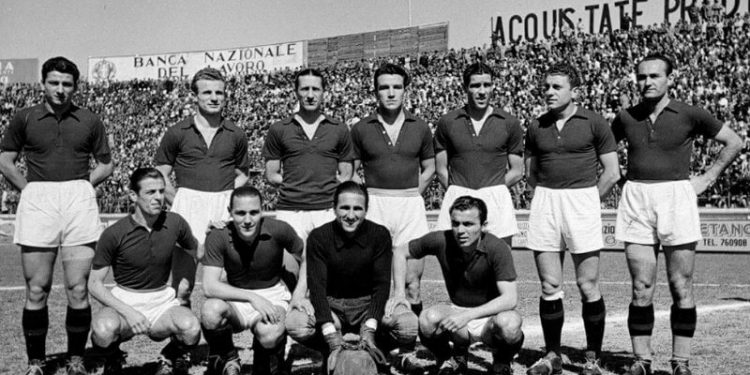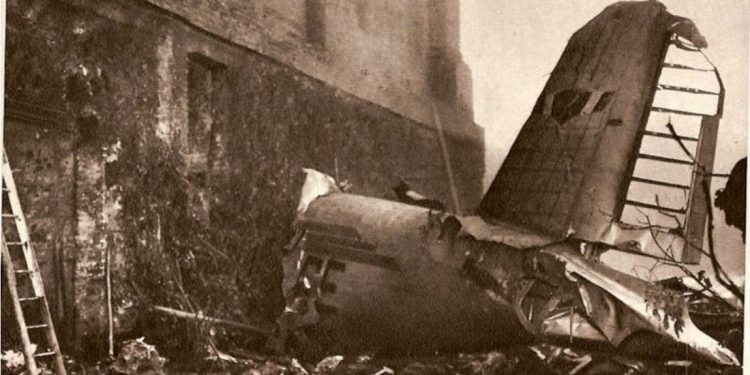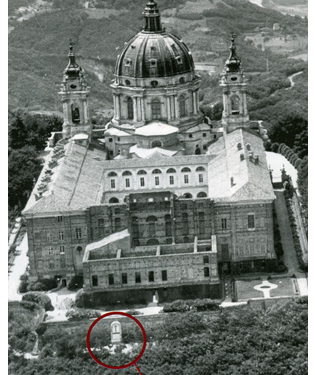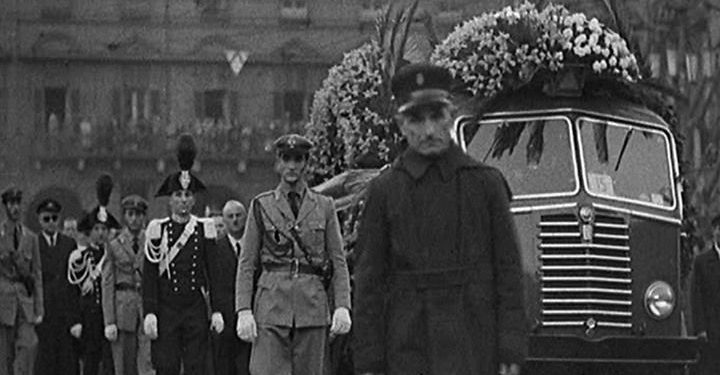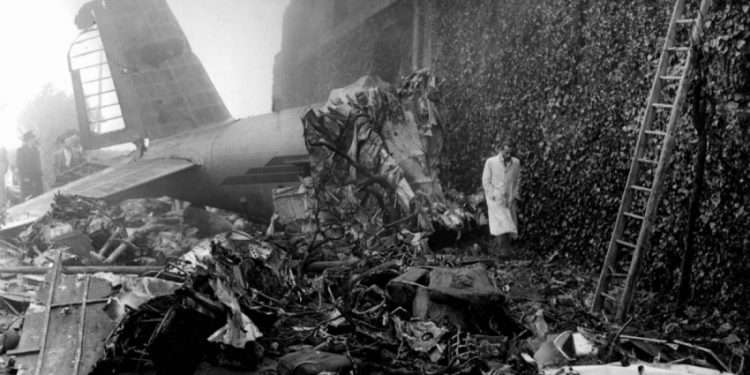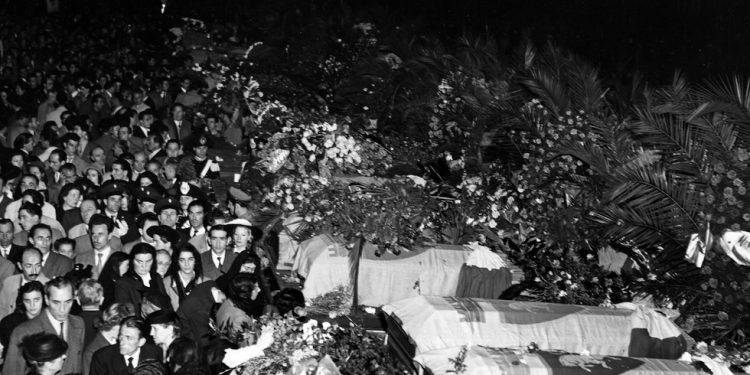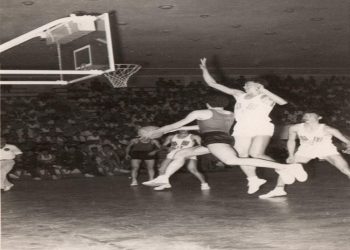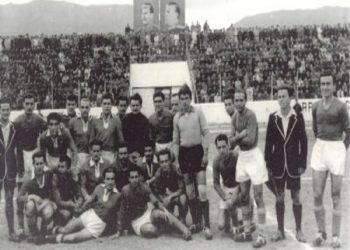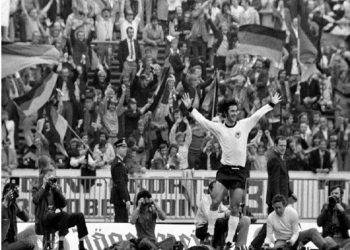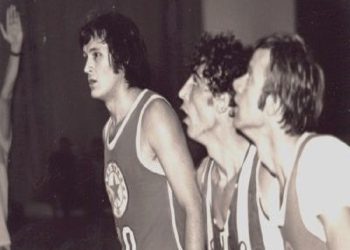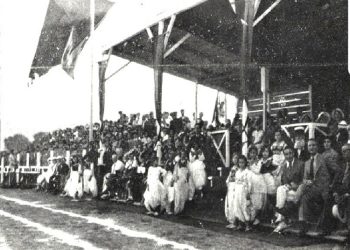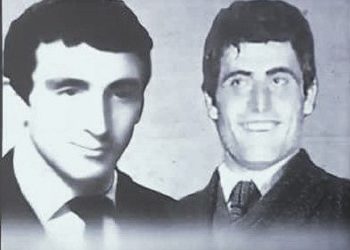Memorie.al Tragic story of the famous Italian team of Greater Turin, who lost their lives in a plane crash on May 4, 1949, in the Turin Alps, returning from a match with the Benfica of Lisbon, where the famous Valentino Mazzola loves Farewell to football. The tragedy happened because of the pilot who changed the itinerary and who were the players and other members of the Torino staff who lost their lives in the fatal collision with the banner of Superga church.
In this glittering atmosphere of football, where the attention and eyes of millions of fans have turned to German stadiums, where the final act of the 18th World Cup competition is being played, there are probably few fans who know the meaning of some players’ gestures. Italians, who after scoring a goal, open their wings imitating the flight of a plane. That imitation is not just their usual fad, as many other teams, mainly African or Latin American, are used to celebrating in their own way. pay tribute to their predecessors to the famous Greater Turin team of the 40s of the last century, who on May 4, 1949, lost their lives in a tragic plane crash in the Turin Alps as they returned from a friendly match with Benfiken of Lisbon, specially organized for the legend, Valentino Mazzola, who was saying goodbye to football.
But because of that tragedy, that match was the last of all the other Greater Turin players, with 11 of them playing in the Italian national team. But under what circumstances did that tragedy happen, who were the footballers and other members of the Torino staff, who lost their lives in that plane crash, and with what honors the stars of that famous team, who made a big name in history, were escorted to the last residence? of Italian and world football?
The brilliance of a great team
The Greater Turin team experienced its most glorious era during the ’40s when it dominated European and European football. It was a rare occasion for this team, with its 11 players also playing with the Italian national team of those years. Despite not being able to dominate a world or European championship, the short but glorious success made it to the top. him as one of the best Italian teams of all time.
In 1941-1942, Turin presented its superb image, winning all Italian football competitions, thanks to legendary players such as Mazzola, Gabetto, Loik and the famous goalkeeper Valerio Bacigalupo. But it was the fatal collision in the dome of the church of Superges (the Turin Alps) that drove this wonderful team.
Excellent results in the war years
From 1939 to 1943, the fascist regime had introduced Italy into World War II, and through football, that regime wanted to show that it dominated Europe and the world in sports as well. In this context, they got promising players from Italy’s top teams such as Milan, Inter, Juventus, Brescia, etc. and formed their representative team in important international competitions. And the excellent results did not delay: Torino – Palermo 3-0, Sampdoria – Torino 2-3, and Fiorentina – Torino 0-2. And this thanks to capable coaches like Egri Erbstein and Leslie Lievesley. On January 17, 1943, Anglo-American aircraft bombed the Philadelphia Stadium and Turin was forced to play in another stadium. The best result that the Turin team achieved thanks to their game was the defeat of Milan in Venice 4-0, which made it possible to win the Italian Cup. Then came the defeat of the Hungarian national team 3-2 in Turin. It was Ferrucci Novo (Torino industrialist) who financed the famous squad and players such as Big Valentino, Ballarin brothers, Romeo Menti and other players, who turned their team into a myth. But it was the fateful match, Benfica-Torino in Lisbon, that took the life of the whole team. The secret of the Turin team’s victories centered on the famous VM system, imposed by Arsenal coach Herbert Chatman. The great team of Turin became famous thanks to other players such as Grava, Grezar, Moroso, Martelli, who managed to raise the name of this team.
Turin’s last match in Lisbon
Details of this tragic match are given by Sauro Toma, who miraculously escaped the tragedy from a minor pre-match injury, which made him not go to Lisbon with teammates. In his memoirs he says the tragic Benfica – Turin was not played for any European competition, but merely for the fact that Mazzola’s captain wanted to bid farewell to a football match against the strong Portuguese team of Lisbon, SL Benfica. But it was this tragic event and trip from Lisbon to Turin that caused the unexpected disaster. Benfica – Turin match ended 4-3 for the locals and immediately after the match the Italians, who said it was just a routine match, got ready with their suitcases to board the Fiat G-212 and travel in Barcelona, and then in their homeland. It was a mystery how the pilot, Pierluigi Meroni, changed the itinerary from Lisbon directly to Turin without refueling the aircraft; But another version is given by the great team’s backup goalkeeper, Renato Gandolfi, who explains that a simple Fiat G-212 aircraft carrier has suffered engine failure or fuel leakage. The most trusted version is given by the Catholic high priest of the church of Superges, where the tragic event occurred, which recalls that the moment the tragedy occurred, it was very cloudy weather and the rains were the final factor causing the collision. Onboard were also special players such as Raf Vallone, who later became a sports journalist and interviewed writers of the time, such as Ernesto Hemingway and others. The Turin team at that time also played foreign players such as Lusu (Romanian), Schubert (Hungarian) and Bongiorni (French), who were considered to be the best foreign players in the Italian Championship for 1945- 1949. But they all fell prey to the sudden disaster in the Turin Alps.
How the tragedy happened in the church
The roots of the big air tragedy start in the last match of the Turin team with the Portuguese team Benfica in Lisbon. The only survivors of the air crash were Sauro Toma and Renato Gandolfi, who did not assist in that last match due to injuries. The match was in honor of the great captain Valentino Mazzola (father of famous Italian football player of the 60-70s, Sandro Mazzola) who wanted to say goodbye to football and Turin. In Portugal, the Turin’s were hardly beaten by the locals with a 4-3 score, as the Italians considered it a common match for their team, not attaching much importance to the score. But none of the players thought that that match in Lisbon would be the last for them, with the players and all the team staff taking their suitcases and leaving for their homeland. The flight journey was Lisbon-Barcelona-Turin, as the stops in these cities would be refueled, but the flight was not observed by the pilot and the flight departed for Italy directly. The tragedy happened at 5:06 pm when the plane was traveling in the Turin Alps. And at this time the pilot reports of a minor defect in the engine, but no one paid any attention to it, as the Turin were celebrating in the aircraft Mazzoles’ departure from the sport. And then there is the unexpected. The plane crashes into the dome of the basilica of the church of Superga, knocking it to the ground and damaging to death all the legendary players of the team, along with the coaches and other members of the constituent staff. Turin. The players who lost their lives in that air disaster were: Bacigalupo, Mazzola, Menti, the Ballarini brothers, Loik, Martelli, Operto, Moroso, Grezar, Grava, Fadini, Castilian, Gabetto, Ossola, Rigamonti, Bongiorni, Schubert; coaches Egri Erbstein and Lievesly; executives Agnisetta and Civalleri; masseur Corina and journalists Casalbore, Cavallero and Tosatti. While the crew members died; pilots Meroni, D’inca, Pangrazi, Biancardi.
The last leader to lose his life was Andrea Bonaiuti. The bodies of football players and all other members of the Turin staff were carefully lowered from the church dome by rescuers and firefighters who arrived at a record time at the scene, and their identification, which presented considerable difficulty, was made by the coach of the Italian national team, Vittorio Pozzo (world champion).
Superga victims were given a grand funeral in their hometown of Turin. More than a million Italians had gathered in the main square of the city, with dead bodies being laid at the Madama Palace, where recent homage was being paid. from top European and world football delegations. The bodies of the players were placed on the truck and a long line of people marched on the Turin boulevards. The last inaugural speech on the deceased players was delivered by the President of the Italian Football Federation, Ottorino Barassi, who stood in front of Mazzola’s body and quoted the famous words: “Captain Valentino, this is the Grand Cup, the Turin Cup, which is in everyone’s heart. ” And with these words ended a glorious and tragic era of Italian football.
Memorie.al




